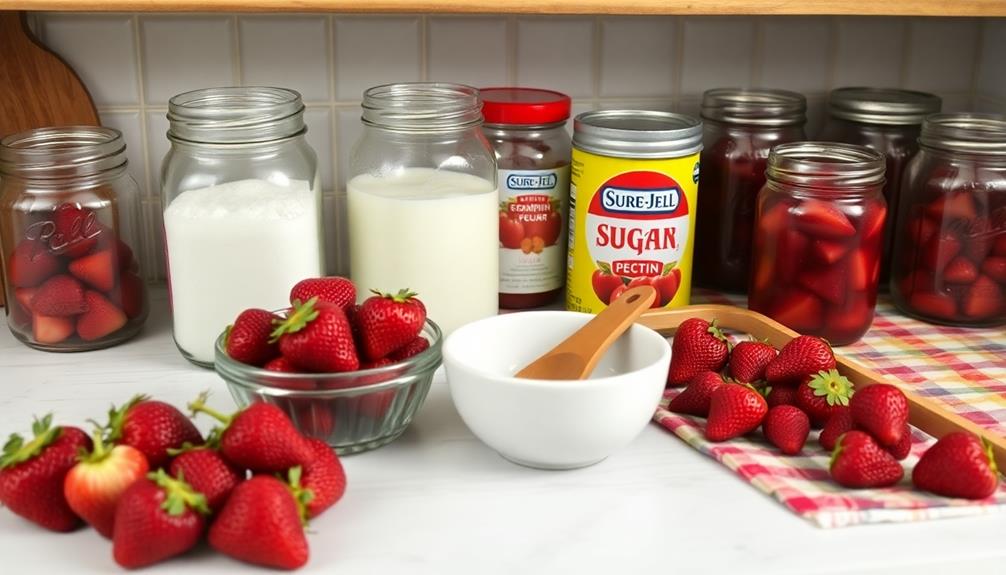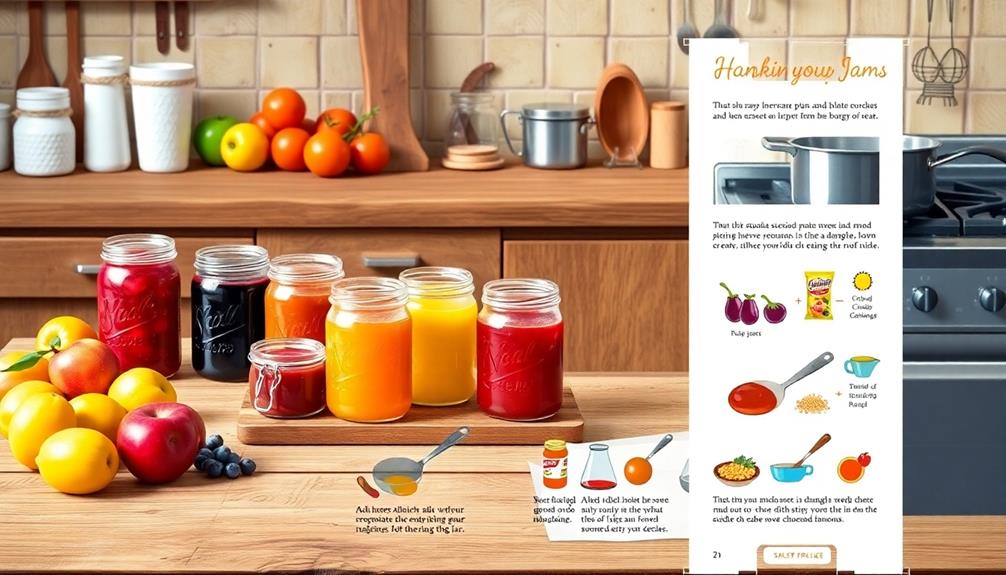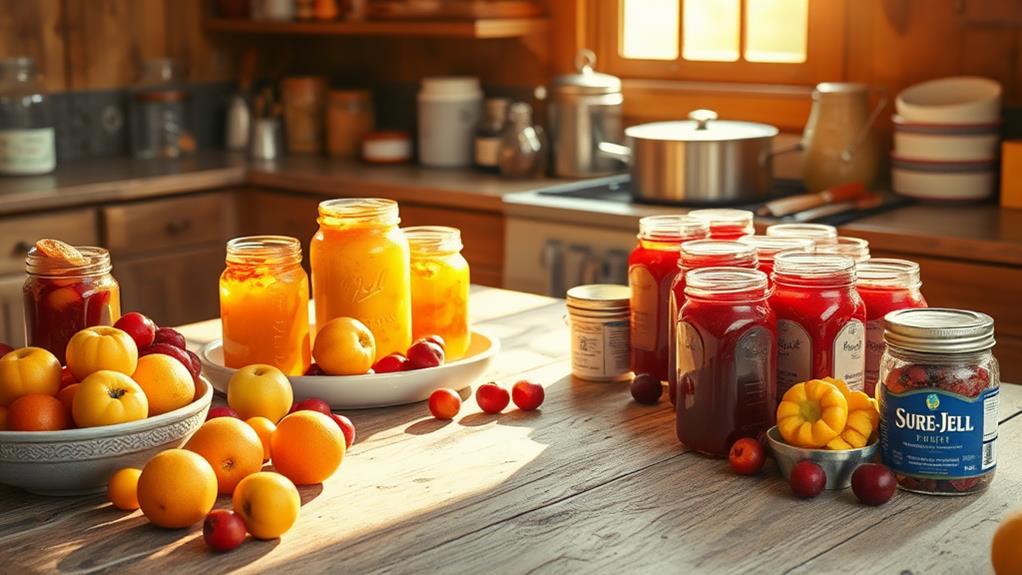Making homemade Sure-Jell recipes is a great way to create frugal preserves that will enhance your pantry without breaking the bank. Using fresh or frozen fruit, you can whip up delicious jams and jellies at a fraction of the cost of store-bought options. With just a few ingredients like fruit, sugar, and Sure-Jell, you're on your way to creating tasty treats. Plus, these preserves last for up to a year when canned properly. If you're curious about essential tips and techniques for the process, there's plenty more to explore that can help you craft the perfect batch!
Overview of Homemade Preserves
When you plunge into the world of homemade preserves, you'll discover a delightful way to capture the essence of your favorite fruits. Whether you choose fresh or frozen fruits, you can whip up a variety of flavors that cater to your personal taste. A simple jam recipe often involves cooking the fruit with sugar and fruit pectin, which helps achieve the perfect consistency. You can even adjust the sugar content to meet your dietary needs by using homemade Sure-Jell or alternative pectins.
Additionally, keeping track of your ingredient costs and preserving supplies can enhance your budgeting strategy, leading to better resource allocation for future batches (financial management insights).
The process of canning your preserves in sterilized jars not only locks in flavor but also extends the shelf life to up to one year when stored properly. Don't hesitate to experiment with different fruit combinations and flavor enhancements like citrus zest or herbs to elevate your creations.
Proper storage techniques are essential, too; keeping your jars in a cool, dark place and regularly checking the seals can maintain the quality and safety of your homemade preserves.
Benefits of Using SURE JELL
Using SURE JELL can transform your jam-making experience by providing consistent results and saving you time in the kitchen.
This reliable pectin product simplifies the process, allowing you to enjoy your homemade jams and jellies without the stress of uncertainty. Additionally, utilizing tools that promote financial awareness can help you manage your pantry budget effectively.
Here are three key benefits of using SURE JELL:
- Quick Thickening: It accelerates the thickening process, enabling you to create delicious preserves in a shorter cooking time compared to traditional methods.
- Reduced Risk of Runny Jams: With the right amount of pectin, SURE JELL minimizes the chances of ending up with runny jams, ensuring a stable and enjoyable consistency.
- User-Friendly Instructions: Each package comes with detailed instructions and sugar recipes, making it easy for both beginners and seasoned canners to create perfect jams and jellies.
Essential Ingredients for Strawberry Jam

When you're ready to make strawberry jam, knowing the essential ingredients is key to your success.
You'll need fresh strawberries, the right type of sugar, and a box of SURE JELL pectin for that perfect texture.
Utilizing coupon codes for ingredients can also help you save money while stocking up on these essentials.
Let's explore how these ingredients work together and whether fresh or frozen strawberries are your best bet.
Key Ingredients Overview
To create delicious strawberry jam, you'll need five key ingredients that work together to guarantee the perfect balance of flavor and texture. Each component plays a crucial role in achieving that sweet, fruity spread you love. Here's what you'll need:
- Fresh Strawberries: Use 5 cups of crushed strawberries, which is about 4 pints. Freshness is key for great flavor!
- SURE JELL: A box of SURE JELL (the original yellow box) provides the necessary pectin to help your jam set properly.
- Sugar: You'll require 7 cups of sugar. This not only sweetens the jam but also contributes to the setting process, ensuring your recipe turns out perfectly.
Don't forget to add 1 teaspoon of butter to enhance the jam's flavor and texture, resulting in a smoother finish.
Before you start cooking, make sure all your ingredients are prepared and measured. This preparation will streamline the process and lead to successful jam-making.
With these essentials on hand, you're well on your way to creating a delightful strawberry jam that's perfect for your pantry!
Sugar Types Comparison
After gathering your key ingredients for strawberry jam, it's important to contemplate the type of sugar you'll use. Traditional recipes often call for a high sugar-to-fruit ratio, like 4 cups of strawberries to 6 cups of sugar. This helps achieve the right consistency and preserves your jam effectively.
Sugar isn't just for sweetness; it also inhibits bacterial growth, guaranteeing your jam remains safe to eat.
If you prefer a healthier option, low-sugar recipes can work too. You can use 6 cups of strawberries with just 4 cups of sugar, provided you choose the right pectin to help it set properly.
Remember, the natural sugars in strawberries contribute to the sweetness, but additional sugar is usually necessary for that perfect gel formation.
If you're considering alternatives, sweeteners like honey or stevia can be substitutes, but you'll likely need to tweak both the type and amount of pectin to guarantee your jam sets correctly.
Each sugar type brings its own flavor and texture, so experiment to find what you enjoy most in your homemade strawberry jam!
Fresh vs. Frozen
The choice between fresh and frozen strawberries greatly impacts the flavor and texture of your homemade jam. Fresh strawberries are typically preferred for their vibrant flavor and natural sweetness, while frozen berries offer convenience, especially when fresh options aren't available.
Here are some key points to take into account when deciding between the two:
- Flavor and Sweetness: Fresh strawberries usually deliver a richer taste, but frozen strawberries can enhance the jam's consistency due to the extra juice they release upon thawing.
- Preparation: You'll need to wash and hull fresh strawberries, while frozen berries must be thawed before mashing. Capturing the juice from thawed frozen berries is vital for proper setting.
- Sugar Ratio: No matter which type you choose, maintaining the right sugar-to-fruit ratio is essential, with a standard recipe calling for about 5 cups of crushed fruit to 7 cups of sugar.
Ultimately, whether you use fresh strawberries or frozen berries, your jam can be delicious and satisfying—just pay attention to the details for the best results!
Canning Supplies You Need
When diving into homemade canning, having the right supplies is crucial for success. You'll need jelly jars, lids, and rings to properly seal and store your delicious jars of jam.
Consider exploring some top expense management apps that can help you track the costs of your canning supplies and ingredients. Start by sterilizing your jars; place them in an oven set to 200°F for about 20 minutes. This step guarantees a safe environment for your preserves.
A funnel is another must-have tool, helping you pour jam into the jars without making a mess. You'll appreciate this when you're working with those cups of strawberries!
Additionally, using a magnetic lid lifter makes handling hot lids much easier and safer during the canning process.
While a water bath canner is optional, it's highly recommended, especially for high-acid foods like fruit preserves. It can give you extra confidence that your jars seal properly.
Before you begin, take a moment to organize all your supplies. Having everything in place will streamline the process and help you focus on creating those tasty preserves.
With the right tools at hand, you're well on your way to canning success!
Step-by-Step Jam Directions

As you commence on making your homemade jam, start by washing and preparing your fruit—removing any stems or leaves—and crushing it to your desired consistency. You'll want to measure out your crushed fruit, usually around 4 cups, depending on your recipe. Tracking your expenses while making these preserves can help you stay on budget and make informed financial decisions, enhancing your overall financial management skills.
Next, combine the crushed fruit with CERTAIN JELL pectin, sugar, and a touch of butter in a large pot. Stir the mixture continuously while bringing it to a boil. This is essential, as you're aiming to dissolve the sugar completely.
Here's a quick checklist to follow:
- Boil for One Minute: Once the mixture reaches a boil, maintain a rolling boil for one minute to make sure it sets properly.
- Jar It Up: Pour the hot jam into sterilized jars, leaving appropriate headspace. Wipe the rims clean before sealing with lids and bands.
- Process the Jars: Finally, process the jars in a boiling water bath for the recommended time based on your altitude. Allow them to cool completely before checking seals and storing.
Now, you're well on your way to enjoying delicious homemade jam!
Tips for Perfect Strawberry Jam
To whip up the perfect strawberry jam, start with the freshest strawberries you can find. You'll need 5 cups of crushed strawberries, one box of SURE JELL, and 7 cups of sugar for a classic recipe that sets beautifully.
When cooking, add 1 teaspoon of butter to enhance the flavor and texture, making your jam irresistible. For those managing their finances while preserving, consider using tools like FreeAgent to track expenses associated with your canning supplies.
Before you fill your jars, don't forget to sterilize them. Place the jars in an oven set to 200°F for 20 minutes; this step is essential for effective food preservation.
If you're at a high altitude, adjust your cooking time accordingly—add up to 20 minutes if you're above 8,000 feet to guarantee the jam sets properly.
Once you've filled your sterilized jars with hot jam, let them cool for 24 hours. After that, check the seals to confirm that your strawberry jam is preserved correctly.
Proper sealing guarantees your delicious creations last longer in your pantry, ready for you to enjoy anytime. Follow these tips, and you'll have perfect strawberry jam that brings the taste of summer right to your table.
Storing Your Homemade Jam

When it comes to storing your homemade jam, keeping it in a cool, dark place is key to maximizing its shelf life.
To further guarantee your jam stays fresh, consider implementing an organized approach to your pantry inventory, similar to the way you'd manage bill tracking tools.
Check your jar seals regularly to ensure freshness, and remember to refrigerate opened jars.
Ideal Storage Conditions
Storing your homemade jam in the right conditions is essential for preserving its delicious flavor and quality. To make certain your jam stays fresh, follow these ideal storage guidelines:
- Temperature: Keep sealed jars in a cool, dark place, ideally between 50°F and 70°F. This helps maximize the shelf life of your preserves.
- Seals: Always check the seals on your jars before consumption. If you find any unsealed jars, refrigerate them and use within a few weeks to maintain freshness.
- Opened Jars: Once you've opened a jar, refrigerate it immediately. Opened jars can last up to three weeks in the fridge, but it's best to consume them sooner for the best flavor.
For long-term storage, consider freezing your homemade jam. It can last up to six months in the freezer without losing flavor or texture.
Remember to label each jar with the date and type of jam to keep track of freshness and guarantee proper rotation in your pantry. Following these tips will help you enjoy your homemade jam at its best!
Shelf Life Tips
Properly storing your homemade jam is key to enjoying it at its best for as long as possible. Sealed jars can remain shelf-stable for about one year when you keep them in a cool, dark place. This guarantees ideal shelf life and flavor retention.
Before you plunge into your delicious preserves, make certain to check that the seals are intact to prevent spoilage and ascertain safety.
Once you open a jar, store it in the refrigerator and aim to consume it within three weeks for the best taste and freshness. If you've got excess fruit and want to preserve more jam, consider using your food processor to create batches and freeze them. Frozen jams can last up to six months, making it a convenient option for long-term storage.
For enhanced shelf life, focus on proper sealing techniques. Always use new lids and verify your jars are clean before filling them. The boiling process during canning helps eliminate bacteria, but double-checking your seals afterward is essential to keep those pesky germs at bay.
With these tips, you'll savor your homemade jam for months to come!
Jar Seal Checks
Checking the seals on your jars is an essential step in guaranteeing the safety and quality of your homemade jam. Proper jar seal checks can prevent spoilage and keep your preserves fresh for longer. Here are some steps to follow:
- Press the Lid: Before consuming, press down in the center of the lid. If it pops back, the jar isn't sealed properly and should be refrigerated or reprocessed.
- Inspect for Spoilage: Always check for signs of spoilage like mold or off smells before using your jam. This guarantees you're consuming safe, sealed jars.
- Store Correctly: Keep your sealed jars in a cool, dark place, ideally not exceeding one year for ideal quality.
If you find an unsealed jar, you can refrigerate it for up to three weeks, but it's best to consume or reprocess it promptly to avoid spoilage.
For best practices, label each jar with the date and type of jam to track freshness and guarantee you use the oldest jars first.
Following these steps will help you enjoy your homemade jam safely and deliciously!
Exploring Sugar-Free Options
If you're looking to enjoy delicious homemade jams without the added sugar, exploring sugar-free options can be both satisfying and healthier. With the rise of AI-driven tools that help optimize product discovery, you can easily find the best ingredients for your preserves.
You can create a delightful sugar-free strawberry jam using homegrown strawberries paired with liquid stevia, which offers a sweet taste with minimal calories. By using no-sugar-needed pectin like Sure-Jell, you can achieve a perfect jam consistency without traditional sugars, relying on the natural sugars found in the fruit.
When making your jam, remember that liquid stevia is a popular choice, but you can also experiment with monk fruit extract, honey, or agave syrup. Just be prepared to adjust the quantity to suit your taste preferences.
Homemade sugar-free jams are perfect for preserving in the freezer, lasting up to six months while retaining the rich flavor and nutritional benefits of the strawberries.
It's important to be aware of the natural sugars in strawberries, such as glucose, fructose, and sucrose, especially if you're monitoring your sugar intake. By utilizing these sugar-free options, you can relish your homemade jams guilt-free, enhancing your pantry with healthier preserves.
Using Frozen Strawberries

Using frozen strawberries can be a game-changer for your jam-making adventures. They break down easily, releasing more juice and creating a smoother consistency.
When using frozen strawberries, here are some tips to guarantee your jam turns out perfectly:
- Thaw Before Use: Make sure to thaw your frozen strawberries completely. This step is vital for capturing the juice that enhances flavor and texture.
- Measure After Thawing: After thawing, measure your cups of crushed strawberries to maintain the correct sugar-to-fruit ratio. This guarantees your jam sets properly.
- Enhance Flavor: For an extra kick, consider adding a splash of lemon juice or zest. This balances the sweetness and elevates the overall taste.
Using frozen strawberries not only allows you to enjoy delicious jam year-round but also simplifies the process.
You can prepare your jam whenever you want, making it a convenient option for preserving seasonal flavors. So, next time you're ready to make jam, don't hesitate to grab those frozen strawberries from your freezer!
Community Tips and Recipes
Sharing community tips and recipes can elevate your homemade Sure-Jell experience to new heights. One of the best pieces of advice from fellow canners is to always use ripe fruit. This guarantees your preserves are bursting with flavor and sweetness.
Don't forget to pre-measure your ingredients; it makes the canning process more efficient and enjoyable.
Engaging with local food preservation groups can be incredibly beneficial. You'll discover unique flavor combinations that you mightn't have considered before, such as mixing berries with herbs or citrus.
Many experienced canners also recommend experimenting with various fruit pectins, including low-sugar and organic options, to accommodate different dietary needs.
When it comes to sealing techniques, maintain proper practices to guarantee your preserves last. Community feedback often emphasizes the importance of checking seals after cooling and storing jars in a cool, dark place.
By following these tips and sharing your own experiences, you'll not only create delicious preserves but also foster a sense of camaraderie within your canning community.
Conclusion
In summary, making homemade preserves with SURE JELL not only saves you money but also fills your pantry with delightful flavors that'll make even the pickiest eaters swoon. By following these simple steps and experimenting with different ingredients, you'll unveil a treasure trove of delicious jams that can elevate any meal. So grab your canning supplies and start creating your own culinary masterpieces—your taste buds will thank you, and your pantry will never look more glorious!



